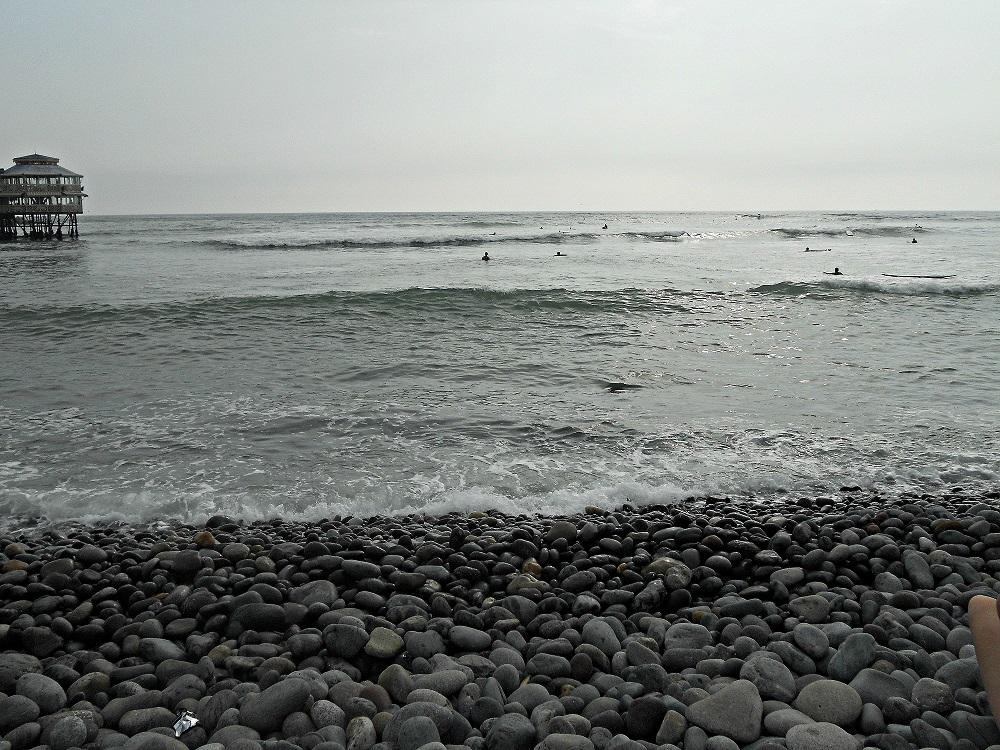Field trip flashback: Peru at Christmastime
May 21, 2015
For a week over Christmas break, North Cobb’s Magnet Program sent students, teachers, and parents alike on an educational tour to Peru. The trip, lasting seven days, took students all over the country, from Lima to Cuzco to Ollantaytambo. They visited museums, historic sites like Machu Picchu, and even a school, learning as much as they could about the Peruvian culture before it was time to go.
“The trip was an incredible experience,” said AP Human Geography teacher Mr. Auld, who led the trip. “It was my first time in South America, the first time I’ve had adults on a tour I’ve led, and the first trip we’ve taken over the Winter Break. On all three counts, the trip was even better than I expected it to be.”
Day 1: Fly to Peru
Students going to Peru met early Monday morning at 5:00 A.M. to gather at Atlanta International Airport. About 32 students and 7 adults trickled in slowly as the hours went on. Although some scheduled did not show up until very late (and one had to cancel altogether), the air continuously buzzed with everyone’s anxious excitement. The excitement mounted as NC’s group boarded the plane when the attendant called, settling into the seats.
“It was dark out, so most of us just slept or watched TV,” said sophomore Shelby Singleton. “I remember watching 22 Jump Street and also sleeping for most of the way there. It wasn’t a particularly long flight, though.”
The group landed in Lima at lunchtime and met their tour director, Washington, whom the kids just called Washy. At five five, Washy possessed dark hair and a tan, emulating a happy attitude and speaking English well.
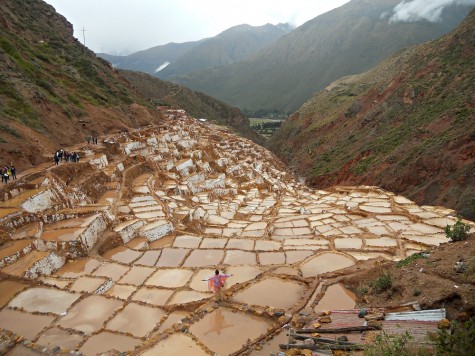
Maras, Cusco rests as an archeological site known for salt flats and salt evaporation ponds, still in use since Inca times. “I really enjoyed the salt flats because it was so extraordinary to see how these people used such advanced methods, with aqueducts and canals, to create something they needed and wanted,” said junior Nolan Hubbard.
“Washy was really great,” said sophomore Jessica Campbell. “He was really sarcastic and told us really amazing stories about his childhood and Peru in general. He was just a really great tour guide.”
The tired group drove to their hotel to drop their luggage off. The rooms proved a surprise, each possessing four beds and enough space for the items they needed. After getting settled, NC students ate dinner and went to the Larco Museum, a privately owned museum of pre-Columbian art located in the Pueblo Libre District. With ancient Peruvian treasures, the group roamed rooms full of pottery, stone and wood carvings, gold and jewelry, and textiles, covering more than 5,000 years of pre-Columbian history.
“The museum had pre-Incan and Incan silver and gold jewelry and metalworking, which was my favorite part,” said junior Christina Sorensen. “It was just incredible to imagine that they created that thousands of years ago.”
Then, exhausted from their journey and excursions for the day, they drove back to their hotel and retired to bed.
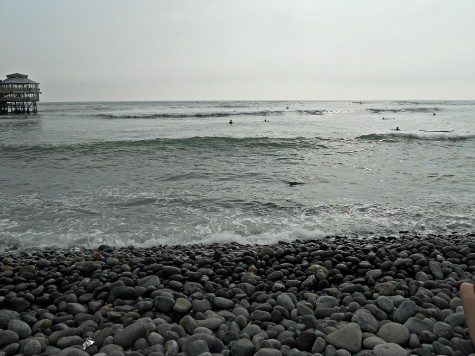
The capital of Peru, Lima remains a highlight for tourist attraction, with numerous activities to undertake, including visiting its famed beaches. “I loved visiting the beaches in Lima, because they were so pretty and a really unexpected thing to find in the city,” said junior Christina Sorenson.
Day 2: Lima
The NC group woke up early in Lima, at approximately seven. They ate breakfast and then embarked on their schedule for the day: a guided tour of Lima. Their first stop was the Government Palace of Peru, also known as the House of Pizarro, which exists as the residence of Peru’s current president, Ollanta Humala. There, they witnessed the changing of the palace guards, which takes place precisely at noon.
““It was really big, a lot bigger than I expected, and it was really pretty. It had a lot of interesting artwork,” said Singleton. “My favorite was the changing of the guards, though, because it was so uniform and precise.”
The group’s next stop, the Archbishop’s Palace, remains the administrative headquarters of the Roman Catholic Archdiocese of Lima. They then proceeded to City Hall, followed by Plaza Mayor, the birthplace and core of Lima. While there, they entered the Basilica Cathedral of Lima, entering through Portada del Perdón, or the “door of forgiveness.”
“The cathedral was beautiful,” said senior Anna Levy. “It was so big and so peaceful, and the artwork was extraordinary. The design and feel of the cathedral was just indescribable, it was so pretty.”
The group then received free time, where they could visit buildings around the area such as the San Francisco Monastery and eat lunch. Once the break was finished, the group went to the National Museum of Archeology and Anthropology, the largest and oldest museum of Peru. It contains artifacts from over 100,000 years of history in the region that now rests as Peru.
“The museum My favorite part of this was we got to see the normal collections, which were really cool, but then we also got to see the storage too,” said junior Nolan Hubbard. “They had hundreds of thousands of clay pots just stacked on top of each other. It was amazing to see.”
Soon after, the group took a walking tour of Miraflores, a district of the Lima that people know for its shopping areas, gardens, parks, and beaches. With many sites to visit for touring groups, it rests as one of the more affluent districts of Lima.
“Miraflores was the cleanest and most welcoming district of Lima. It was the city’s financial hub and I could definitely imagine myself living there” said Sorensen.
They spent the rest of the day at Miraflores and then proceeded back to their hotel, exhausted from the day. They packed up their bags in preparation for the flight the next morning, and slept early for their early wake up call.
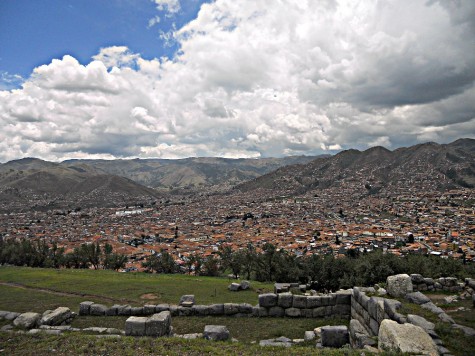
Reaching the top of Machu Picchu, the group saw the entire city of Cusco from a birdseye viewpoint, giving way for a spectacular site that astounded NC.
Day 3: Lima and Cusco
On the third day of NC’s Peru trip, the time of their flight to Cusco forced the group to wake up at six in the morning. After their excursions the day before, most felt strongly the weariness and exhaustion accompanying waking up. Yet the flight, only an hour and fifteen minutes, amazed the students and adults.
“The flight was awesome because it was really pretty,” said junior Adrian Vivona. “You know how in America we look out windows and go, ‘Ah, man, look at those streets’? Well, we flew in between mountains, which was really cool.”
Once they landed, the group took a bus to Qurikancha Temple, the Inca ruins of a temple existing in the 1400s that was transformed by the Spanish but still retaining Inca structure. The temple was once covered in pure gold, but after almost a thousand years of existence, it proved in a little disrepair.
“It was really pretty,” said sophomore Andrew Gasparini. “There was a lot of artwork there, from the Inca times and from the Spanish. The architecture and layout of the entire thing was also really nice, like there were gardens and a nice courtyard in the middle. So it was very beautiful.”
The group then proceeded to Ollantaytambo, a small town and Inca archaeological site that rests approximately 60 kilometers northwest of Cusco, along the Andes Mountains.
“I loved the Andes Mountains,” said sophomore Shelby Estroff. “They were so beautiful I couldn’t stop staring at them on the train ride to Ollantaytambo.”
The group was able to walk around the area, experiencing streets so narrow only one car could fit down the road at one time; some roads proved too narrow even for that. While there, they visited a woman who raised a herd guinea pigs in her kitchen to eat.
“Ollantaytambo was a really nice place,” said Mancuso. “You could feel the history and you could even see it, because almost everywhere we went had some sort of story.”

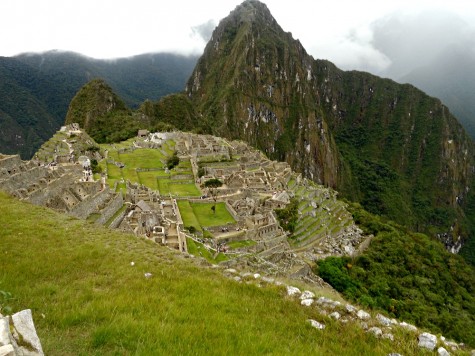
The pinnacle of the trip for many students and adults, Machu Picchu sits as one of the Seven Wonders of the World. The students spent the day in the area, marvelling over the history and architecture of the citadel.
Day 4: Machu Picchu The group woke up excited to visit Machu Picchu. They were told only to bring an overnight bag, as they would leave all their luggage at the village hotel they were leaving. After packing their necessities, the group arrived at the train station, where they would take a train to get to Machu Picchu, a ride that would take approximately one hour and thirty minutes. “We were all really excited to go to Machu Picchu, and even though the ride was long it was worth it,” said Mancuso. “As we climbed higher, we all got more and more excited to arrive.” Once their train trip ended, they boarded a bus that would take them to Machu Picchu, an Incan citadel high in the Andes Mountains. The group proceeded to climb the 3,000 stairs up to the Wonder of the World. The weather proved cloudy, a storm brewing in the distance, but the NC group was so high up the clouds were on top of them. On Machu Picchu, they were almost 8,000 feet above sea level. “Machu Picchu was the most extraordinary place I’ve ever been to,” said Campbell. “It felt like we’d just walking into the past, which was so cool and such an amazing feeling.” After lingering in the area, the group proceeded to climb up to 9,000 feet to visit the Gate of the Sun. The walk was about a mile, but the stairs proved extremely steep, with no apparent organization to the size or height of each step. It began raining as they climbed, and by the time the group made it to the Gate, everyone was soaked. “Once you got past the exhausting walk up, it was completely worth it, because the view was something like I’ve never seen,” said AP US History teacher Mrs. Rankenburg. “You could see so much of the valley, all from above.”
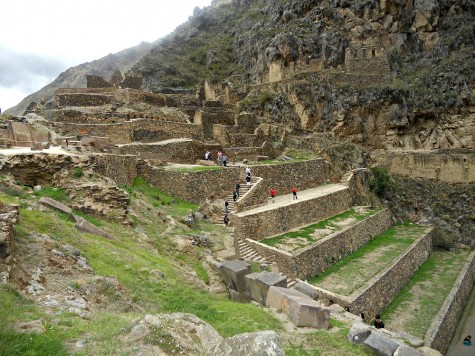
On the fourth day of their trip, the group climbed a mile from Machu Picchu to reach the Temple of the Sun, which was located as high up as possible so as to contemplate heaven more closely.
NC toured the area until time to climb back down. The uneven rocks were saturated with water, making them slippery. The group made it down after careful maneuvering and the avoidance of the drop next to them, then took the twenty minute bus ride back to the train, and the train back to the Machu Picchu Pueblo Hotel for the night, which was undergoing construction at the time. “It wasn’t the best hotel we’d stayed at, because parts were open to the outside and there were a lot of bugs in the room,” said junior Haven Hardgrave. “I’m glad we only stayed one night.” Yet, despite the hotel, the trip to one of the Seven Wonders proved a rousing success, with the visit creating unforgettable memories in NC students, parents, and teachers; it landed a place in many people’s favorite moments of the trip. “While it may be cliché to say that one of the Wonders of the World was a favorite part, it was,” said Auld. “Beginning with the train ride there and ending with our hike to the Sun Gate, it was full of memories that no matter long I travel with the Magnet program I will never forget.”
Day 5: Ollantaytambo and Pisac and Cusco On the fifth day of the trip, the group left the Pueblo Hotel behind and took a train back to Ollantaytambo. They arrived back at their original hotel to drop off their overnight bags, then left to take a tour of the Sacred Valley, rich in Inca history. “There was so much to do at the valley,” said Hubbard. “We saw some really cool things, and there was so much history, past and present, about the Inca and about Peruvian traditions.”
Once the tour ended, the group took a more in depth tour of Cusco, one the capital of the Inca empire and, as such, possessing rich historical significance and known for its archeological remains and colonial architecture. The group’s lunch break proved the time the group tried guinea pig for the first time.
““It tasted kind of like chicken, but it was much chewier than that. It wasn’t bad, but I wouldn’t eat it again,” said Singleton.
After eating their full, the group travelledthe Pisac Market, where the group was paired with a local woman, who attempted to teach NC how to weave in their native tradition. The women also taught the group how to tell if an item was made with real or fake alpaca fur, aiding them in their searches for souvenirs.
“Interacting with the local people was also one of my favorite aspects of the trip,” said Auld. “It was incredible to get to have that time with someone from another culture and attempt to communicate with no common language.”
The group bought what they desired and explored the Pisac Marketplace before making their way back to Cusco.
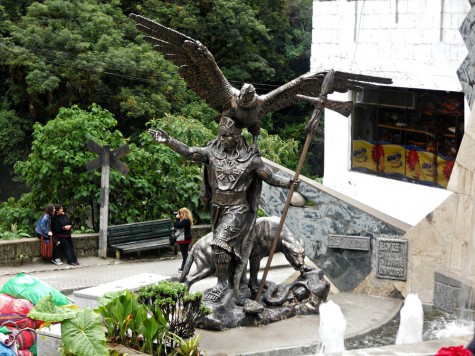
Illustrating the various beliefs and traditions of the Inca people, which survive today, this statue depicts in the Inca concept of Heaven, represented by a bird; Earth, depicted by a puma; and the Underworld, depicted by a snake.
Day 6 and 7: Cusco
For their sixth day, the group enjoyed a free morning in Cusco. They were allowed to visit any museum or shop they wished, the only requirements remaining to stay in groups and to watch the time.
“Basically they were like, ‘You can walk ten blocks up the streets as long as you’re back on time,’” said Vivona. “So we were going to go to the art museum but then we decided not to, so we went to the chocolate museum, and we bought some really good chocolate. It was the last of my money but their chocolate was so good that I couldn’t not buy it.”
After their relaxed morning, the group visited a local school at 12,000 feet altitude, increasing 3,000 feet from their previous location. At the school, they conducted a ceremony in which NC students and adults bought the children fruit and bread. The mothers of the village operated a weaving shop where kids could buy souvenirs or donate.
“It’s always a very eye-opening experience to see kids who have nowhere near as much as our kids, still going about their normal day,” said Rankenburg. “We took them fresh fruit, and they were really excited about that. Overall it was a very rewarding experience.”
Once they left the village, they took the hour long bus ride down to their hotel, where the students were given the option to stay at the hotel or explore the shopping center. They spent the remainder of the day in free time, and for dinner the group tried alpaca.
“Eating alpaca kind of tasted like steak,” said Levy. “It didn’t look weird, like I thought it would. It just looked like regular meat, and it tasted a lot better than guinea pig did.”
After dinner, the group retired to bed, waking up on the seventh day for more tours of Cusco. They group also visited Maras and Moray. In Maras, a town in the Sacred Valley, the group explored salt evaporation ponds, in use since Inca times. In Moray, an archaeological site, the group viewed unusual Inca ruins consisting of large circular depressions, thought to be a sophisticated irrigation system.
“It was super cool, because we jumped over and down on the different tiers and I almost tripped, but it was great,” said Gasparini. “The stepping stones up were just enormous. It was really fun.”
After their excursions, NC went to bed early in expectation for their flight in the morning.
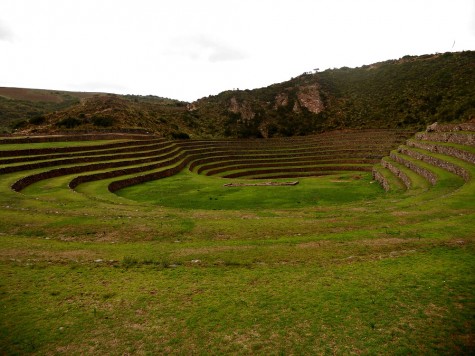
On the seventh day, the NC group visited Moray, an archeological site known for its unique agricultural model. “We were told that it was a very experimental use, with each tier of the valley being used for different crops, taking into account the different altitudes and climates,” said sophomore Andrew Gasparini. “It was such a cool things to learn about and to see with our own eyes.”
Day Eight: Lima and Flight Home
On the final day of the Peru trip, the group woke up early and headed to their airport to board their flight back to Lima.
“We were running all over the airport because they kept changing the gate we were supposed to be departing from,” said Hardgrave. “It was stressful, and we were relieved when we finally got on the plane.”
Once the landed, they drove to their hotel, dropped off their luggage, and arrived at a mall they visited the last time they were in Lima. There, the group spent most of the day until they left for dinner at the Bullfighter’s Restaurant.
“His house was also a hotel and bed and breakfast thing, and it was very extravagant,” said Gasparini. “The food there was also really good.”
Because their flight left at one in the morning, the students rested as much as they could before arriving at the airport, where they took the flight back to Georgia. They then drove home to recuperate in time for school the next day.
For many, this trip prove fun, educational, and interesting. It will serve as an unforgettable memory, with unforgettable people, for those who travelled to Peru. One will find many of these attendees advocates for travel and for travel to Peru.
“I would absolutely recommend this trip to anyone,” said Auld. “Some of the most amazing things to see around the world won’t last forever, and taking advantages of opportunities that come along the way is very important.”
